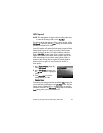Chapter 2: Taking Pictures and Recording Video Clips 47
The Image Quality setting not only affects the quality of the
images but, as a result, also the number of images that can be
stored either in the internal memory in the camera or on an
optional memory card. Higher resolution and lower
compression images will take up more space than images with
lower resolution and/or higher compression. For example, the
highest setting, 3MP
Best, results in high quality images, but
consumes more storage space in memory than the next lower
setting, 3MP. Likewise, many more still images can be stored in
memory at the 1MP or VGA settings than at 3MP; however,
these settings will result in much lower quality images.
The Pictures remaining count at the bottom of the Image
Quality sub-menu screen updates when you highlight each
setting. See Memory Capacity on page 148 for more
information about how the Image Quality setting affects the
number of images that can be saved in the internal memory in
the camera.
The Image Quality setting (in the previous table) will appear in
the Live View screen. The new setting remains in effect until it is
changed again, even when you turn the camera off.
NOTE When you use digital zoom, the resolution changes as
you zoom in. See Digital Zoom on page 35.
White Balance
Different kinds of lighting conditions cast different colors. For
example, sunlight is more blue, while indoor tungsten light is
more yellow. Scenes dominated by a single color may require
an adjustment of the white balance setting to help the camera
reproduce colors more accurately and ensure that whites
appear white in the final image. You can also adjust the white
balance to produce creative effects. For example, using the Sun
setting can produce a warmer look to the image.


















